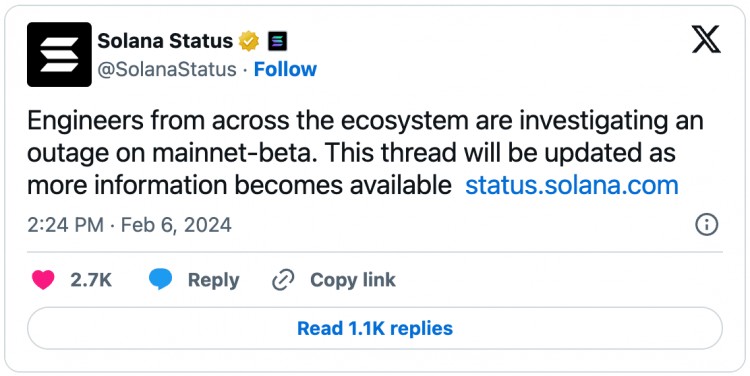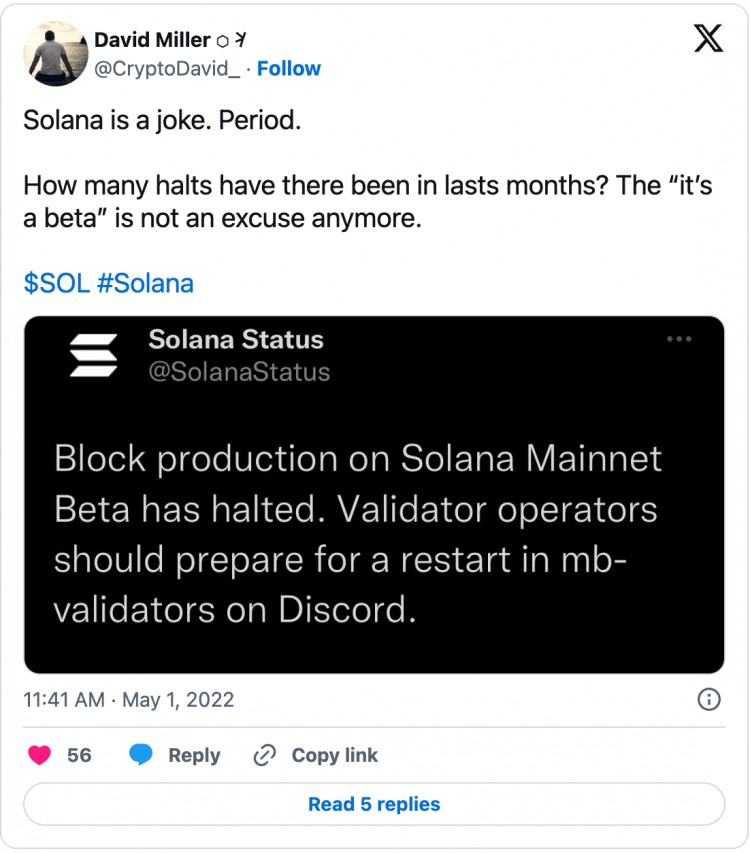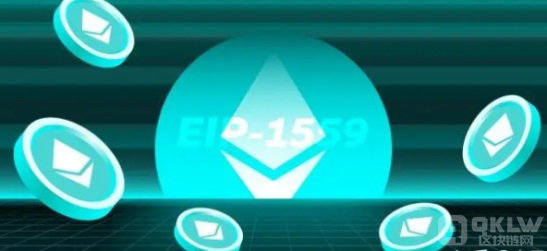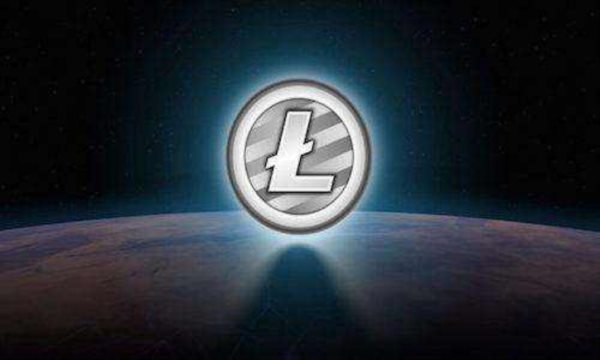時間:2024-02-28|瀏覽:299
Solana 網絡于世界標準時間 2 月 6 日上午 10:22 經歷了嚴重中斷,區(qū)塊生產暫停了五個多小時,然后驗證器重新啟動了網絡。
這并不是 Solana 第一次宕機。 自 2022 年 1 月以來,Solana 已發(fā)生大約六次重大停機和十五天部分或重大停機。

這些事件的嚴重程度各不相同,從部分網絡中斷到全部網絡中斷,其原因包括網絡中的軟件漏洞以及拒絕服務和資源耗盡攻擊。
尸檢
Solana 于 2 月 9 日發(fā)布了最近一次中斷的事后報告,詳細說明了其原因以及驗證器如何重新啟動網絡。 該報告顯示,Solana 的即時 (JIT) 編譯緩存遇到了該錯誤,該緩存會在執(zhí)行事務之前編譯所有程序。
早些時候,JIT 緩存是使用“ExecutorsCache”實現(xiàn)的,但是,在 v1.16 版本中,ExecutorsCache 被名為“LoadedPrograms”的新實現(xiàn)所取代。 新的加載程序使用存儲在程序鏈上帳戶中的會計信息來查找其最近的部署槽,并使用它來計算有效的槽高度。
然而,該加載程序遇到了遺留加載程序問題,導致 JIT 緩存遇到舊程序的循環(huán),導致它重復重新編譯它們,而不是有效地訪問和執(zhí)行它們的指令。 這一故障導致網絡停滯,因為系統(tǒng)陷入無限循環(huán),無法處理交易或繼續(xù)前進。
Solana 戰(zhàn)略主管 Austin Federa 告訴 Cointelegraph,有一個用新電機系統(tǒng)替換舊裝載機系統(tǒng)的過程,但計劃在更新版本中禁用它。
“看起來有人故意調用那個舊指令集,它已經很長時間沒有使用了,但仍然存在于代碼庫中。
JIT 編譯器遇到了無法找到所需內容的問題。
這就是無限循環(huán)的原因。”
Solana 工程師很快發(fā)現(xiàn)并修復了問題,更新了系統(tǒng)進程,并識別了這些舊程序以防止未來的重新編譯周期。 該解決方案需要減少麻煩的遺留加載程序的部署,以確保可以準確有效地訪問所有程序指令,而不會陷入重新編譯陷阱。
一些批評者表示,導致 Solana 中斷的一個重要因素是缺乏客戶端多樣性,從而導致潛在的中心故障點。 開源去中心化交易平臺 Komodo 的首席技術官 Kadan Stadelmann 告訴 Cointelegraph,Solana 的開發(fā)人員和驗證者優(yōu)先考慮快速傳輸代碼,而不是維持完美的網絡正常運行時間,并補充道:
“The key reason is centralization and lack of validator client options. Solana’s ambition for high throughput and low transaction times puts immense pressure on its infrastructure, making it susceptible to performance degradation and outages.”
However, Federa suggests Solana possesses much more accurate architecture and explains that only two smart contract networks worldwide have independent validator clients: Ethereum and Solana. Currently, Solana has one major validator client built on one functional codebase.
“Solana has never had an outage due to a fault in consensus or something along those lines. The problems have always been implementation details. It’s always been that there’s been a bug somewhere in the implementation layer, which is not better or worse. It’s just an important kind of accuracy,” Austin explained.
The Solana blockchain was launched in March 2020, and over the next four years, the network has made significant strides in the decentralized finance (DeFi) ecosystem. Solana ranks as the fifth-largest DeFi chain in total value locked, with over $1.7 billion in capital allocated to different on-chain protocols. Its native Solanatoken has a market valuation of around $49 billion, making it the fifth-largest cryptocurrency.
Despite a magnificent track record, Solana has never officially come out of its beta phase. The blockchain is still referred to as being in mainnet beta. Beta is a term that refers to nearly finished software that a select group of users is testing before an official launch.
However, the Solana blockchain is open to everyone, with hundreds of decentralized applications utilized to launch various products. The blockchain ecosystem also boasts a vibrant nonfungible token (NFT) ecosystem.
Solana underwent brief private and public beta testing before releasing v1.0 four years ago, and today, the network processes more transactions than most other chains.
Even though the code is still changing, Solana is much beyond what can be considered beta software. The persistent misperception results from a mix-up between pre-launch testing and post-launch software maturity and misconceptions around Solana’s messaging.
The beta status has attracted much criticism of the blockchain, especially in light of its outages over the past two years. Crypto users on social media have often mocked that Solana’s status as a mainstream blockchain often changes to mainnet beta and back, depending on whether the chain is down.

Federa claimed that most blockchain systems are in beta today and that only Bitcoin and Ethereum are probably complete mainnets and explained:
“It takes a long time for software systems to stabilize and be feature-complete as important new features are still being shipped on the Solana network. I think we’re probably nearing the end of that beta phase. From a technology standpoint, one of the significant milestones for that will be the launch of a second independent validator client.”
許多 DeFi 支持者認為,Solana 的停機無疑是其成為以太坊競爭對手的障礙。 盡管如此,開發(fā)人員仍在努力確保導致過去停機的錯誤不會影響未來的網絡。 盡管其停機歷史悠久,但其高速度和低成本在吸引新項目到該平臺方面發(fā)揮著關鍵作用。
$SOL
#熱門話題
![[維維安]Solana 中斷引發(fā)了有關客戶多樣性和 Beta 狀態(tài)的問題](/img/btc/27.jpeg)

![[加密大師]Solana 中斷引發(fā)了有關客戶潛水員的疑問](/img/20240228/3629980-1.jpg)
![[加密365]以太坊 Nethermind 客戶端的嚴重錯誤凸顯了客戶多樣性低的風險](/img/20240131/3315466-1.jpg)
![[加密365]以太坊 Nethermind 客戶端的嚴重錯誤凸顯了客戶多樣性低的風險](/img/20240205/3315466-1.jpg)




